Galapagos Islands | November 2010

There are literally hundreds of ways you can book a tour of the Galapagos; however, I can’t imagine going all the way out to the islands without doing a week-long boat excursion. We booked our tour in Quito with Galapagos Last Minute.
They picked us up at our hotel in Quito, escorted us to the airport, and promised to have someone meet us in the Galapagos. The plan was to go directly to our yacht, the Evolution, but it was running late after coming out of dry-dock for renovations. This created a number of problems throughout the week (paint fumes in the rooms, wet |paint on the hull) but otherwise didn’t detract too much from the excursion.
Our yacht was incredibly spacious and comfortable. The crew and service were fantastic. Meals were simply outstanding.
Of course, on land and under water is where the real adventure lies in the Galapagos. This is one of the best places we’ve ever been.
Where: Ecuador
Tour: Galapagos Last Minute / MV Evolution
Cost: $1,975 USD (each, for a group of 7)
Included: Everything for 8d/7n including R/T Airfare from Quito, National Park Fee, on-island transportation, luxury-class sailing, five-star dining, snorkeling equipment, etc.
Baños, Ecuador | December 2010
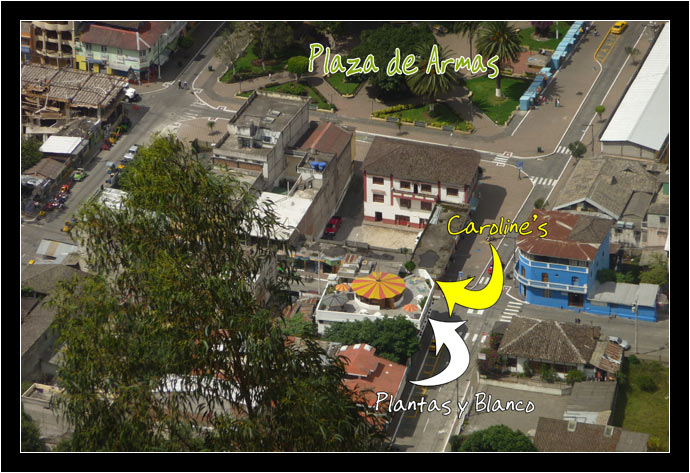
“Carolines Tour Cia. Ltda.” is a tour agency (one of many) in Baños de Agua Santa, Ecuador. We chose it over the other shops because the manager, Nancy Navas, was friendly, patient, and spoke passable English. Just about anything touristy in Baños — and everything in Baños is touristy! — can be arranged from her agency.
Although Oksana and I rented a buggy from Caroline’s for $10/hour and attempted to do a bridge jumping tour (we picked the wrong day; no one was at the bridge), the most significant excursion we paid for in Baños was a jungle tour.
Nancy was very willing to work with us as we tried to get away from the standard jungle tours. She put us in touch with a guide who let us tailor a hike that started out deeper in the jungle (and thus farther from the other tourists.)
Can’t tell you the address — decent maps of Baños are notoriously hard to find online — but it’s directly across the street from Plantas y Blanco.
Where: Baños de Agua Santa, Ecuador
Tour: Carolines Tour (website is supposedly www.carolinestour.com, but I think it’s defunct)
Cost: $140 USD for a full-day jungle excursion (3 people)
Included: Transportation from Baños, two guides, lunch and snacks, rubber boots
Parque Nacional Cajas | December 2010
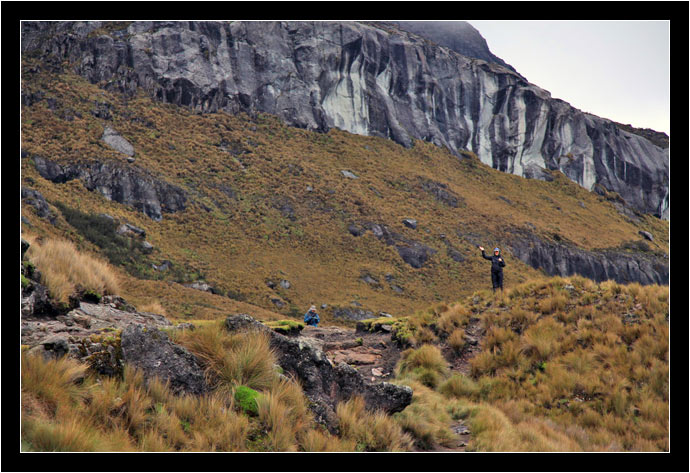
There’s no real need to book a tour to the Parque Nacional Cajas if you’re an experienced hiker. You can simply show up at the “south bus terminal” in Cuenca and catch the 7:20am bus. Tickets to the park cost $3.75 USD and it takes about an hour to get there. Don’t worry, the bus driver will tell you where to get off.
Once at the park, you’ll find a tourist station – sort of a lodge – where your entrance fee gets you a fantastic map/brochure (really, it’s very well done) and directions to the different trailheads. We picked trail #3, the park ranger’s suggestion for a single-day hike. The map said it would take 6 hours and 55 minutes to hike the 8kms and damn if we didn’t arrive at the end in exactly that amount of time!
Bring warm clothes (layers), including a rain jacket, gloves, food and water. Cajas is a part of the páramo (above 3000m), and if it isn’t raining when you start hiking, it probably will be before you’re done.
Where: Near Cuenca, Ecuador
Tour: N/A Parque Nacional Cajas
Cost: Around $10 USD total, including transportation
Included: Nothing but a map is included, so make sure you pack a day bag appropriately.
Parque de la Reserva (Park of the Reserve) | January 2011
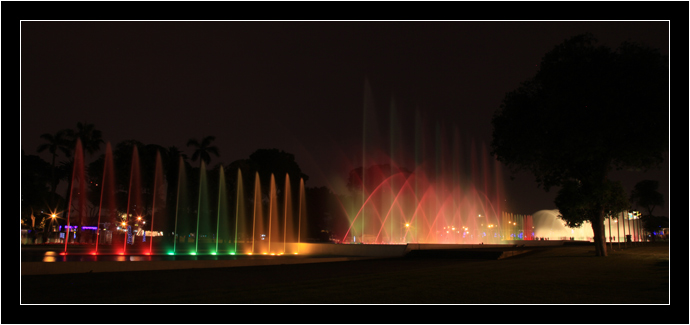
In the heart of Lima, Peru, there is a new public park full of fountains. If you want a nice way to spend an afternoon, milling around with a couple thousand locals, looking at all manner of beautiful fountains, this is the place for you.
Just after sunset, they put on a laser-light show with accompanying classical music along with video projections onto the cascading water itself. Quite the show.
Where: Lima, Peru
Tour: Parque de la Reserva N/A
Cost: 4 pesos, or about $1.40 USD (plus public transportation to the park)
Included: Nothing, really. Just bring your camera and take some pretty pictures.
Colca Canyon | January 2011
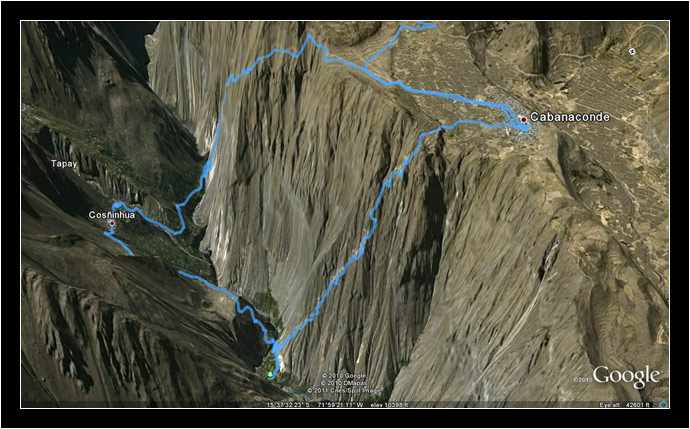
The Colca Canyon is either the first- or second-deepest canyon in the world, depending on who you talk to. Either way, it’s an impressive sight!
We booked a 3d/2n hiking excursion with Land Adventures out of Arequipa. Pretty much everything was covered in the $100 USD pricetag: 5 hour transportation from Arequipa (including stops for breakfast and lunch), a stop at scenic viewpoint to watch for Andean Condors, an English-speaking guide to lead you down into the cabin, lodging for two nights in the villages both in and above the canyon, and a van ride back to Arequipa.
The hike is tough, but very much worth the effort. The first day is about a 7-hour hike down to the river at the bottom of the canyon, before climbing a few hundred meters up the far side before arriving at the first village for the night. The next day is another 3 hours of hiking parallel to, and then back down to the river, before you arrive at an oasis for lunch. There you can lounge around in hammocks, take a dip in the concrete pools, or just lounge around on the rocks. Finally, you have to psych yourself up for a steep, but rewarding climb back up and out of the canyon. Your reward is a nice hotel with plentiful hot water and dinner with your new hiking friends.
There are even a few surprises along the way back to Arequipa. More scenic viewpoints, the opportunity to pose with a tame eagle on your arm, and to soak out some of the soreness from two full days of hiking… a nice, hot public hot spring.
Where: Arequipa, Peru
Tour: Land Adventures
Cost: $100 USD, plus $21 USD optional donkey to ride up canyon (or have it carry your bags), plus $3.50 USD optional hot springs
Included: R/T Transportation from Arequipa, all food and lodging for 3d/2n, English-speaking guide
Boleto Turistico del Cusco | January 2011

Cusco is a huge travel hub in Peru. The amount of things to see and do there can be overwhelming. You can go through your guidebook and tick off everything you might want to do, but there’s a better way: Buy yourself a Boleto Turistico del Cusco (Cusco Tourist Ticket).
The Cusco Tourist Ticket isn’t terribly inexpensive, but it grants you access to 16 different museums and archeological sites (ruins) in and around the city. I guarantee that if you see everything on the ticket, you won’t feel like you’ve missed out on anything while you’re there!
A couple notes: The ticket is only good for 10 days following its purchase, so don’t buy one if you’re planning to sit around. While it’s quite possible to visit all the museums on the ticket in one day, many of the ruins are spread out around Cusco and throughout the Sacred Valley of the Incas. It took us 5 fairly full days to visit them all.
Also, you should sit down with a map to figure out the best way to approach some of the ruins. For instance:
Tipón and Pikillacta should be visited together, as they’re both in the same direction out of Cusco.
Consider seeing Pisac on the weekend so you can also visit the Pisac Market.
Moray and Chinchero (and Salineras) can be visited together in a half-day tour from Ollantaytambo
Ollantaytambo (not to be missed!) is where you catch the train for Machu Picchu; plan to visit these ruins on the way.
And my favorite suggestion: Take a cab from Cusco to Tambomachy and then hike back through the open fields back to Cusco. You can visit quite a few other ruins on the way: Pukapukara, Q’enqo, Templo de la Luna, and Saqsaywaman!
Where: Cusco, Peru
Tour: Boleto Turistico del Cusco (Cusco Tourist Ticket)
Cost: 130 soles, about $45.60 USD (50% discount with student ID)
Not included: Transportation to some of the sites.
Included: Entrance to the following sites and museums:
– Museo de Arte y Monasterio de Santa Catalina
– Museo Municipal de Arte Contemporaneo
– Museo Historico Regional
– Museo del sitio Qoricancha
– Museo de Arte Popular
– Danzas Folkloricas
– Monumento Pachacutec
– Saqsaywaman
– Q’enqo
– Pukapukara
– Tambomachay
– Chinchero
– Pisaq
– Ollantaytambo
– Tipon
– Pikillacta
Nazca Lines | January 2011
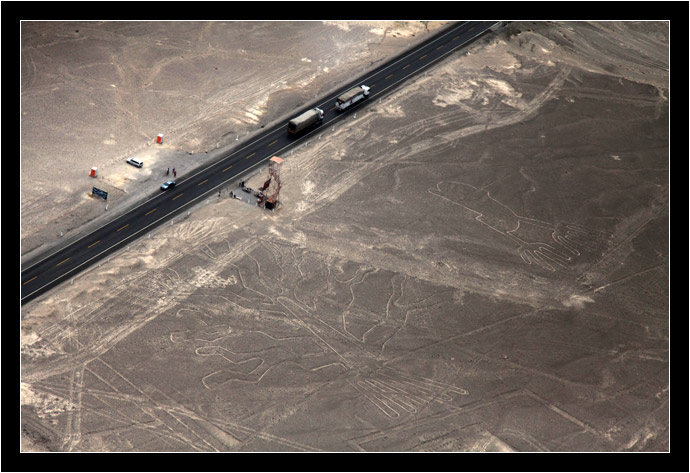
In the middle of the Peruvian coastal desert lines the enigmatic Nazca Lines. Because of the exceedingly stable climate conditions, these kilometers-long lines have survived for hundreds of years. Today they’re the main tourist attraction for miles around.
We booked three tours while in Nazca:
- Aqueduct tour, booked from Hostal Brabant: 25 soles, plus 10 entrance fee (each)
- Flight over the Nazca lines, booked from Hostal Brabant: $120 USD, plus 20 soles (each)
- Palpa tour, booked from the Walkon Inn: 74 soles (each): 60 soles, plus 10 museum entrance, plus 4 to climb two towers
The Palpa tour takes you first to the Maria Reiche Museum where you can learn a bit about the Nazca lines, when they were discovered, and how they were constructed. Then you get to see a few of the lines up close by climbing two lookout towers and then walking out onto a rocky lookout over the desert. It’s probably best to do this tour first, as the knowledge you gain about the lines will pay off when viewing them from a plane.
The Aqueduct tour was also surprisingly informative. Again, you get to visit some of the lines up close before visiting one of the cooperatives that still maintains and uses some of the original aqueducts (or wells) that were dug all the way down to the aquifer below the desert. On the way back to town, you also get to visit a set of ruins.
Finally, the flight over the lines themselves: This tour is a little harder to recommend as not everyone will think it’s worth $120 USD for a 20-minute flight over the desert. Unfortunately, this is the only way to see the majority of the Nazca lines and to get a real sense of their scale. (Personally, I can’t imagine going to Nazca and not paying for a flight…)
Where: Nazca, Peru
Tour: Palpa, via the Walkon Inn
Cost: 74 soles total, or about $26 USD
Included: Transportation to four sites including the Maria Reiche Museum, English-language guide
Tour: Aqueducts, via Hostal Brabant
Cost: 35 soles total, or about $12.25 USD
Included: English-speaking guide, transportation to three sites
Tour: Flight over the Nazca Lines
Cost: $120 USD, plus 20 soles for airport tax (total of about $127 USD)
Included: Taxis to and from the airport, 20-minute guided flight over the desert
Machu Picchu | January 2011
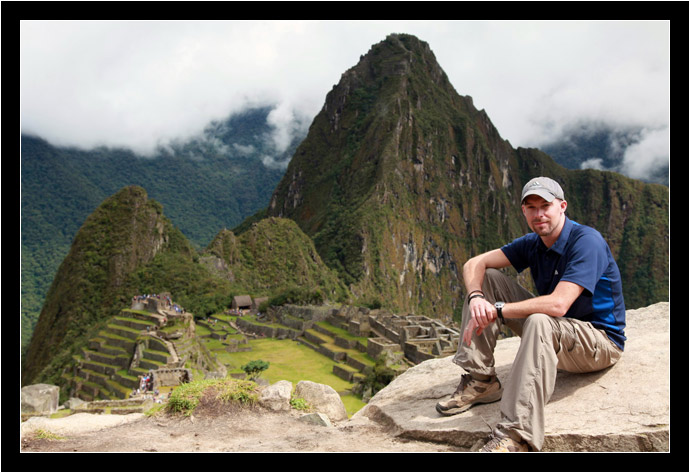
Machu Picchu. One of the Seven NEW Wonders of the World. How many people plan a trip to Peru without a visit to this ancient Incan city? Not many, I imagine.
Through fortune and coincidence, I’ve been to Machu Picchu four times now and I have seen the tourist landscape change a lot over the past 13 years. Anything I write here is likely to be soon outdated, yet again, but it still may be helpful to some.
Machu Picchu is located in a remote, mountainous part of Peru. The two most common ways to arrive there are by train via a small town called Aguas Calientes, or by hiking the Inca Trail. If you have both the time and the money, I highly recommend the hike. Not only will you get to see incredible and varied landscapes, but you’ll also learn about the ruins as you go, building to a fourth-day sunrise over Machu Picchu itself. More importantly, you’ll get to skip the frustrating experience of waiting in multiple endless lines (for tickets, for the bus, for the park…)
Whichever way you decide, you’ll probably start out from Cusco. It’s a good place to book your tour (if you haven’t already paid through the nose via some website.) The train to Aguas Calientes can be picked up there, but you can save a little money by taking a bus to the last stop before Machu Picchu: Ollantaytambo. Ollantaytambo is also very close to where you begin the Inca Trail.
Hiking the Inca Trail takes three days (the fourth day is spent in Machu Picchu.) The altitude can make it a difficult hike at times, especially on the second day when you have to cross through two of the highest passes, but the distances you cover aren’t that great and you can take your time. I also recommend you let a porter carry everything but your camera and water. For $10 a day, they’ll save your back and you’ll give them some much needed financial support.
If you only have time for Machu Picchu itself, the only way to get there is by train and the tourist-tax is quite expensive. The shortest leg is Ollantaytambo-Machu Picchu, about a 2-hour train ride, and the backpacker class is $31 USD each way. (High rollers could spend as much as $641 USD R/T with Perurail’s “Hiram Bingham class” service!) Add to this the cost of the Aguas Calientes-to-Machu Picchu bus ride at $14.75 USD (it’s optional, but if you skip it you’ll have a 6km hike up a very steep mountain first thing in the morning), and the park entrance fee itself at $44 USD and you’re looking at over $120 just to see Machu Picchu. That maybe doesn’t sound like much for a once-in-a-lifetime experience, but compared to the rest of Peru, it’s a huge chunk of change!
Once in Machu Picchu, you have free reign to roam pretty much wherever you like. Any decent map or guidebook will lead you to the most interesting corners of the park. Don’t miss out on the 15-min walk to the Incan Bridge or a visit to the llamas lounging around near the Hut of the Caretaker of the Funerary Rock (move slowly and you can walk right up and pet some of them!)
Huayna Picchu, the signature peak seen in all the classic Machu Picchu photos can also be climbed, but to preserve the trail, they’re now limiting the number of people who can climb it each day. You’ll have to get up very early to get one of the passes. We arrived at the bus stop at 5:30am, exactly when they depart for Machu Picchu, and there were at least a dozen full buses in front of our own. We were literally hundreds of people back in line at the park, but miraculously we were still about to secure Huayna Picchu passes that day. To guarantee your choice of hiking times (there are only two departure time slots: 7-8am and 10-11am), you’ll probably need to be in line for a bus at 4:30am.
I strongly recommend you plan to spend at least two days in Machu Picchu. The weather changes quickly in the mountains and you could end up with a full day of rain clouds socking in the park. Having a second day set aside also means you don’t have to rush through the park and it gives you a greater chance of being able to climb Huayna Picchu, too (if you so desire.) Finally, with the extra time, if you’ve seen everything on your list, give Montaña Machu Picchu a try. It’s much higher than Huayna Picchu, so the trail is a lot longer (but blessedly not as steep!), and the views of the park, mountains, and Rio Urubama are spectacular!
There are so many ins and outs to doing Machu Picchu on your own that it’s hard to cover it all in a “brief” tour review like this. If you’re planning your own trip there and have any questions, don’t hesitate to ask.
Where: Machu Picchu, Peru
Inca Trail
Tour: SAS Travel (I went with SAS in 2008, not on this trip)
Cost: $350-500 USD
Included: All inclusive: English-speaking guide(s), R/T transportation from Cusco, 4 days hiking with tents, sleeping bags, 3 meals and 2 snacks a day, 1-day pass for Machu Picchu, return by train
Not Included: Porter for personal gear ($10 USD per day), tips for guide, cook, and porters
Machu Picchu
Tour: N/A
MINIMUM Cost: $121 USD (total)
126 Pesos ($44 USD) park fee, per day
42 pesos ($14.75 USD) R/T Bus from Aguas Calientes (optional, but recommended)
$31-334 USD (depending on class of service) train from Ollantaytambo to Machu Picchu on PERURAIL
$31-307 USD (depending on class of service) train from Machu Picchu to Ollantaytambo on PERURAIL
Included: R/T transportation from Ollantaytambo to the park
Not Included: Guides (available at the entrance to the park), Hotel/hostel in Aguas Calientes, food
Los Uros Floating Islands, Lake Titicaca | January 2011
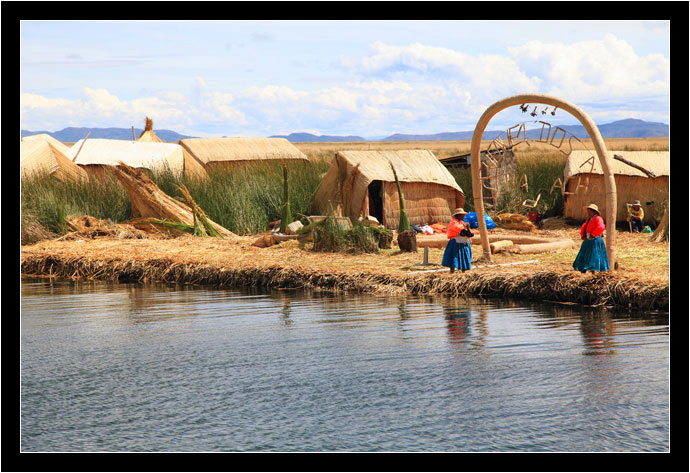
One of the principle attractions on Lake Titicaca is the Floating Islands of the Los Uros people. The islands are very near Puno and you can easily visit them with an inexpensive, half-day tour from the city.
Tour agencies all over town would be happy to take your soles, but they’re only necessary if you like parting with your money. Simply stroll down to the docks and buy a ticket from any of the kiosks with pictures of the islands on them. The next boat is likely to leave in under half an hour and all it’ll cost you is 15 soles.
The boats on Lake Titicaca are, by and large, very slow. It’ll take about 45 minutes to reach the islands, but on a nice day there will be plenty of photo ops along the way. Once there, the “president” of the island will probably sit you down and give a little informational talk about how they live their lives and explain that, yes, while their islands may be anchored to the bottom, they are indeed floating! After his speech, you can walk around and take photos, buy souvenirs from the women, and perhaps (if they offer) even try on their traditional clothes. Some islands have opportunities for lunch or a small tower you can climb for a better view of the surrounding area. The highlight is a ride to another island on one of the reed boats (which costs a little extra, maybe 5 soles more.)
This is the quickest and cheapest way to tour the floating islands, but many of the actual tours offer worthwhile extras. For instance, if you want to get a better sense of Lake Titicaca’s scale, you might look into a full-day trip to Taquile (which also stops at the floating islands) or an 2-day, overnight trip to Amantaní.
Where: Puno, Peru
Tour: N/A
Cost: 15 Soles ($5.25 USD)
Some extras include: Lunch (13 soles), “Museum” (1 sol), ride on a reed boat (5 soles), and, of course, however much money you’d like to spend on souvenirs.
Included: R/T boat ride to one or two of the floating islands, plus a small informational lecture before you’re encouraged to wander around.
The World’s Most Dangerous Road | February 2011
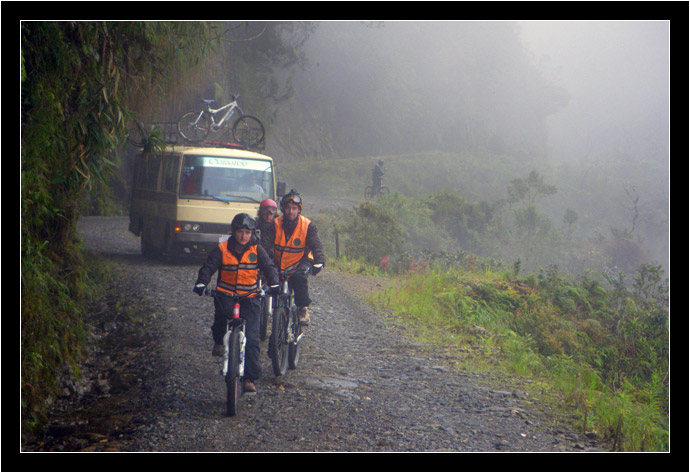
Known as the World’s Most Dangerous Road because of the literally thousands of lives lost over 70 years or so, the Camino de las Yungas connects La Paz to the jungle. Since the new road opened in 2007, traffic on the WMDR has decreased drastically, allowing for the (relatively) safe passage of mountain bikers.
This mountain biking tour is an all-day affair. Gravity Assisted Mountain Biking will take you up to La Cumbre, at 4700m, where you’ll test out your gear before starting down a newly paved road. After an hour or so, you’ll reach the unpaved start of the World’s Most Dangerous Road. The next few hours are adrenaline-packed as you pedal downhill next to steep, deadly cliffs.
It’s not as dangerous as it looks. The guides do a good job keeping the group at respectable speed with 15-17 stops along the way to explain what each new section is like. A chase van follows along behind in case anyone decides it would be safer to ride with them.
You eventually descend all the way to 1100m and discover yourself in a hot, humid, jungle environment. The reward for surviving the trip is lunch at La Senda Verde, an animal refuge where you can interact with the wildlife, take a shower, and even swim in their pool. After lunch, you can take a quick tour of the refuge to see all manner of rescued creatures: Dogs and cats, macaws, toucans, turtles, a caiman, and 3 or 4 different types of monkeys. The highlight is, of course, the curious capuchin monkeys that climb on your shoulders and the spider monkeys that might decide to take a nap on your lap. La Senda Verde was arguably better than the mountain bike ride itself!
I can’t say enough about Gravity Assisted Mountain Biking as a tour company. The cost of the trip ($100 USD) would have been acceptable for just the tour, but the quality of everything surpassed our expectations (And not just for a Bolivian tour, either. The value of this tour would have been great even in the United States!) The mountain bikes they gave us were easily the best bikes I have ever ridden on, with powerful brakes and front and rear shocks. La Senda Verde Animal Refuge was a worthy excursion in and of itself; I can’t believe that was included in the price! Before we left, Gravity loaded us down with high quality “freebies,” like a T-shirt, buff, and playing cards. Sure, everything we left with was emblazoned with their logo and was advertising for them, but I appreciated it nonetheless. If you have time to swing back by the office the next day, you can also pick up a professional-quality CD-ROM of all the photos and videos taken by the guide during your ride! (The only thing that bothered me, as a digital media guy, was that they’d compressed the videos to hell, trying to get them to fit on a CD-R. Time to update your codecs, guys!)
Where: La Paz, Bolivia
Tour: Gravity Assisted Mountain Biking
Cost: Bs 720 ($103 USD)
Included: Afternoon at La Senda Verde, animal refuge
(Tour) R/T transportation from La Paz, Mountain bike rental, helmet, gloves, outerwear (pants and jacket), orange safety vest, ski goggles, 2 guides (at least one English-speaking), snacks, lunch at La Senda Verde.
(Extras) T-shirt with logo, deck of playing cards, pen, buff, and a custom-printed CD of the photos taken during the trip
(Optional) Zipline tour, extra Bs 200 ($28.50 USD), plus you have to take time out from your stay at La Senda Verde
Cal Orcko, Cretaceous Park | February 2011
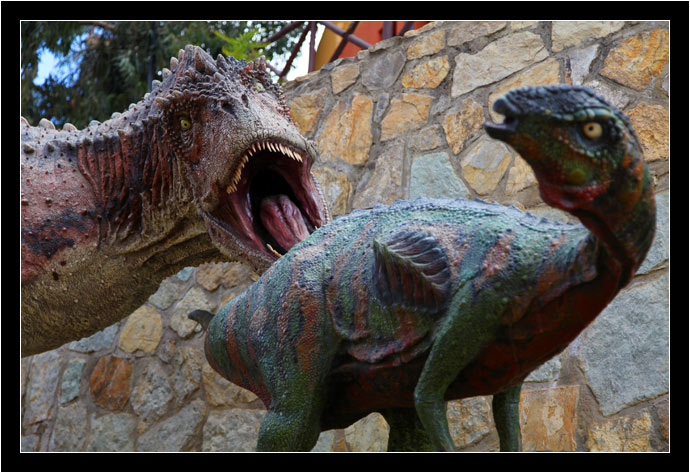
Just outside Sucre, Bolivia, a cement factory that was in the process of slowly taking apart a mountain, made an amazing discovery: A petrified lake bed, upthrust to a 70 degree angle by tectonic plates, contained a series of perfectly preserved dinosaur footprints. Credit to Bolivia for recognizing their find and protecting it! The carefully unearthed mountainside now contains the longest dinosaur tracks in the world.
Cretaceous Park is not much more than an information center and viewing platform across from the hillside with the prints, but it makes for a nice, relatively inexpensive half-day tour. The life-size dinosaur models are truly outstanding – some of the best statue work I’ve ever seen – and we would recommend the park for the statues alone to any family with a young boy. Loudspeakers throughout the park play simulated dinosaur sounds (when they’re off, you can hear the cement plant chugging away next door.) Once in the park, guided tours are free, though it costs a couple quarters if you want to use the platform binoculars.
Catch the “dino-truck” from the main plaza at 9:30am (Bs 17.) There are only 2 trips a day, but if you time it right, you can return to Sucre on the dino-truck, too. If you miss it, just walk downhill from the park to the bus stop: Combi rides back to town are only Bs 1.50.
Where: Sucre, Bolivia
Tour: N/A Cal Orcko/Cretaceous Park
Cost: Bs 30 entrance fee, plus 5 for camera use ($5 USD total), plus ~ Bs 18.50 ($2.65 USD) for transportation
Included: Entrance to the park, use of a camera, free BBC dinosaur documentary showing, and guided tour (in English or Spanish.)
Potosí Mining Tour | February 2011
At 4000m, Potosí is the highest city in the world. The whole reason it’s there (and has been there for hundreds of years) is the Cerro Rico mine – supposedly the richest mine ever found on planet Earth.
Unfortunately, of all the money that comes out of the mine, very little of it goes back into in the form of modern tools and safety equipment. The conditions, some of which haven’t changed since colonial times, are what make the mine tour such an irresistible attraction.
We chose to go with Koala Tours if only because we were staying at the affiliated Koala Den hostel. They picked us up at our hotel, outfitted us with hard hats, boots, and heavy over-clothes, showed us around one of the make-shift ore refineries in town, and then took us to one of the city’s many mining supply stores. There the tour began with an explanation of what the miners and, by extension us, can buy. Beer, water, Coca-cola, carbide lamps, coca leaves, and – let’s not forget the main attraction! – dynamite!
Our tour just so happened to coincide with the ONE day of the year when the miners were celebrating instead of working, so our group explored a maze of completely abandoned tunnels. We walked all the way down to the third level (where the temperature was at least 90 degrees F) before taking a break and then heading back out. The tunnels are low, the atmosphere is hot and humid, silicon dust is in the air and asbestos fibers can be seen on the walls and ceilings. Hiking back out was grueling – at 4000m our lungs burned for air and we were forced to choose between breathing through a sweaty-wet bandana or sucking down lungful of dusty air. This tour is not for the claustrophobic or asthmatic, that’s for sure!
Back on the surface, our guide was happy to assemble any “completos” we had purchased. That is, any bundles of dynamite, sodium nitrate, detonators, and slow-burning fuses we’d brought along. We had two; I mean, they were only $2.85 USD each, you know? Would you believe that two minutes is enough time to pose with the lit stick of dynamite before the low-man-on-the-totem-pole has to run them out to an empty field before they explode?
This was probably the most arduous, dangerous, and depressing tour of our trip so far, but I wouldn’t have missed it. Nowhere else in the world is quite like Potosí.
Where: Potosí, Bolivia
Tour: Koala Tours
Cost: 100 Pesos (about $14.25 USD)
Included: Transportation, protective mining clothes, English-speaking guide
Not Included: “Gifts” for the miners (Sodas, Beers, dynamite, gloves, lamps, etc.)
Salar de Uyuni (World’s Largest Salt Flat) | February 2011
With the possible exception of the Galapagos Islands, the Salar de Uyuni is the most amazing natural wonder we have seen on our trip so far. I can’t recommend it enough!
We toured with Red Planet Expeditions, a travel agency out of Uyuni. The standard “rainy season” tour is a 3D/2N excursion of the salt flats and the high-altitude deserts of southwestern Bolivia (with the option to transfer to a bus bound for Chile at the end of the trip.)
Red Planet has a set itinerary for their tours, and in the rainy season, time spent on the salt flat itself is limited to just a few hours on the first day. If you take the time to communicate what you want, however, they are open to certain changes (for instance, we stayed on the salt flat until after sunset, but then had to return to Uyuni for the night.) If your plan is too far from the norm, they can set up private tours as well, but of course that costs extra. (We talk about these options a bit in the video above.)
Choose your vacation time carefully; both the rainy season and the dry season have their own advantages and disadvantages. In the rainy season, you’ll see incredible reflections of the sky in the water covering the flats, but the drivers won’t take their SUVs any farther than the salt hotel. In the dry season, you can progress much farther out onto the flats, as well as take some incredible, perspectiveless photos.
Where: Uyuni, Bolivia
Tour: Red Planet Expeditions
Cost: 910 Bs ($130 USD) with English-speaking guide, or
700 Bs ($100 USD) with Spanish-speaking guide, plus
Bs 150 ($7) for national park entrance fee (for tours continuing southwest)
Included: All food, lodging, and transportation for 3 days/2 nights, plus entrance permit to the Salar de Uyuni.
Tatio Geysers, Geothermic Field | March 2011

Just browsing through the list of excursions in San Pedro de Atacama can be daunting. The surrounding desert – supposedly the driest place on Earth – is huge and varied. I got the impression that you could spend weeks there, seeing all sorts of natural wonders. We didn’t have much time, so we settled on a tour of the Tatio geysers. Billed as the third-largest geothermic field (after Yellowstone and Kamchatka), it’s in a valley 4,300 meters above sea level, near the Chilean border.
We went with a company called Turismo Grado 10 and I can wholeheartedly recommend them for two reasons: 1) The transportation they use is a cleverly-converted garbage truck – awesome and unique! – and 2) breakfast was fantastic!
They picked us up in front of our hotel between 4 and 4:30am and then drove two hours to the geothermic field. We arrived just before sunrise (when it was -6 degrees Celsius; dress warm!) As the sun rose, we got a quick tour of the geysers and then the opportunity to take a few photos of the underground water’s steam burning off in the cold morning air. None of the geysers were really large, but the number of bubbling pools and hissing vents were impressive.
One of the attractions is the opportunity to sit in a natural hot spring (“Don’t you want to be able to say you took a bath at 4300m when it was below-freezing outside?”) but we found that the pool was only a bit above luke-warm. After trying it for ourselves, I can safely say it wasn’t worth the chill associated with dressing again afterwards!
While you’re in the pool, Grado 10 employees are setting up breakfast. Huge tables and folding chairs make for a comfortable setting and the food – crepes and melted ham & cheese on English muffins – is delicious! Maybe it’s just because we were coming from Bolivia, but I’d say the breakfast alone was reason enough for choosing Grado 10.
Finally, there’s another two-hour drive back to San Pedro (along a different route) with a couple stops to take photos and stretch your legs along the way.
Where: San Pedro de Atacama, Chile
Tour: Turismo Grado 10
Cost: 25,000 Chilean Pesos, plus 10,000 for the national park entrance fee (about $74 USD total)
Included: R/T Transportation (in a garbage truck!), English-speaking guide, large breakfast
Cerro San Cristóbal | March 2011
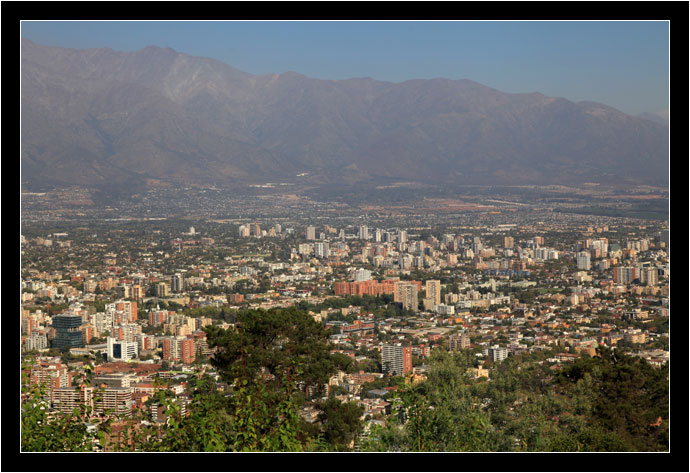
I knew going in that we wouldn’t have a lot of time to spend in Santiago, so I didn’t do a lot of research on things to see. The one thing I did want to do – the sky/cable car thing – turned out to be down for maintenance the one day we were there. Still, we arrived at the same place.
Cerro San Cristóbal is the top of a hill in the middle of the Parque Metropolitano. Even if the sky cars are broken, climbing to the top of the hill is still a worthwhile trip as the views of Santiago on a clear day are remarkable.
If all you want is photos, you can climb the hill yourself for free. If you’d like an easier ride, there’s the sky car of course, or a funicular on the other side of the park. We bought round trip tickets for that and, while it isn’t much of a “ride” per se, it does get you to the statue of the Virgin of the Immaculate Conception without breaking a sweat.
Where: Santiago, Chile
Tour: N/A
Cost: 1,200 pesos (about $1.25 USD) R/T on the funicular
(We didn’t get to do the skycar, but other websites say the price is comparable to the funicular.)
Included: Easier transportation up the hill
Vineyard Bike Tour | March 2011
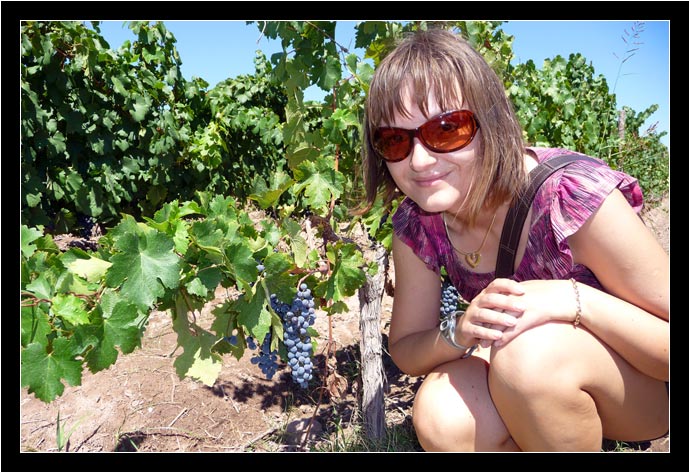
Mendoza is the heart of wine country in Argentina and it wouldn’t be right to pass through without visiting a vineyard or two. Better yet, make a day out of it with a bike tour!
First, take some time to figure out the bus system or grab a taxi from Mendoza to Maipú, as most of the vineyards are away from the city center. Tell the driver you’re looking to do a bike tour and he’ll drop you off at the appropriate place. We chose Mr. Hugo’s Wineries and Bikes.
Once you have your bike and a map (provided by Mr. Hugo himself), you can spend the rest of the day pedaling by the vineyards, taking tours of the bodegas, and sampling wines, olives, liquors, chocolates, and beers. Mr. Hugo’s map alone marks 10 points of interest.
The bike rental isn’t all that expensive (and it comes with as much blank-label wine as you’d like at the end of the tour), but a day among the wineries has the potential to knock your wallet around a bit. Tours and tastings run about 15-20 pesos each and the bodegas that serve lunch don’t have a budget menu! While one could make a day out of this tour for less than $10 USD, a dedicated wine taster could easily spend $60 USD (or more, depending on their ability to remain upright on a bike while heavily intoxicated!)
Where: Mendoza (Maipú), Argentina
Tour: Mr. Hugo (bike rental), plus our can’t-miss recommendations:
Tempus Alba
Vistandes
Chocolatería “A la Antigua”
Museo del Vino “La Rural”
Cost: 30 Pesos (bike rental), plus 2 pesos for the Mendoza-Maipú bus ($8 USD total)
Included: Bike rental for the day, plus free map and wine upon your return
NOT Included: Various bodega tours, wine tastings, lunch, and “liquid souvenirs.”
Quebrada del Condorito National Park | March 2011
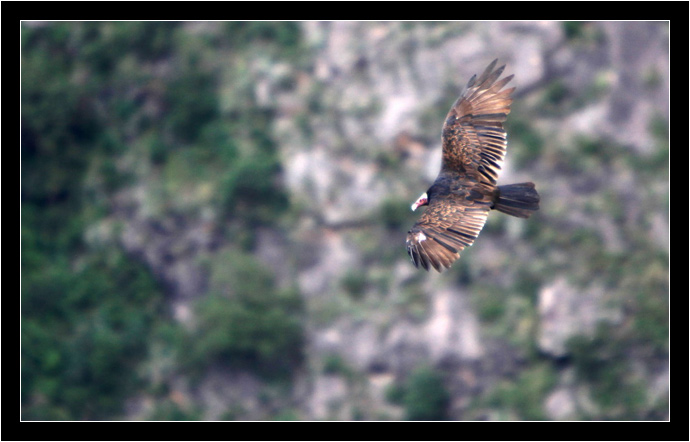
Up in the sierras of Córdoba, Argentina, is a largely empty national park that’s perfect for catching a glimpse of the bird with the world’s largest wingspan: The Andean Condor.
The park itself is free, however it’s a little remote, so you’ll likely have to pay for transportation. We had a friend set us up with a taxi out of San Antonio, but it’s just as easy (and a lot cheaper) to catch a bus in Carlos Paz.
The bus will drop you off on the side of the road and from there it’s about a half-hour walk to the visitor’s center. Entrance, information, and a great map/brochure are all free for the taking. They also have returning bus schedules posted on the wall – take note!
From the visitor’s center, it’s a mostly flat, 2-hour walk (we did it easily in 1.5 hours) to a steep river valley. Along the way, you’ll probably see a few birds and guinea pig-like rodents among the scrubby grass (posted signs warn about snakes and pumas, too.) At the cliff’s edge, there are a couple observation areas where you’ll have the best chance to see the condors flying and nesting. If you packed a lunch, it’s also a great place to find a flat rock and enjoy the afternoon.
The weather in the sierras can change quickly, so bring layered clothes, a rain jacket, food, and binoculars (which, admittedly, has nothing to do with the weather, but are quite useful when trying to tell the difference between a condor and a jote.) Campers can also stay in the park, too, even hiking down into the valley beneath the condors if they so desire.
Catching a ride back to Carlos Paz is as simple as sticking your arm out at buses headed in that direction.
Where: Near Carlos Paz, Córdoba province, Argentina
Tour: N/A (free entrance to the Quebrada del Condorito National Park)
Cost: Transportation only:
80 pesos ($20 USD) for a one-way taxi from San Antonio
13 pesos ($3.25 USD) for the return bus
Included: Free map & information
Zoo Luhán | April 2011
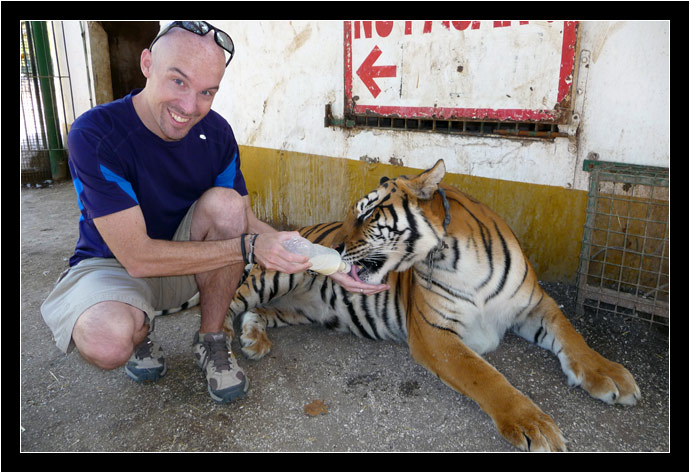
I once saw a map with poor English translations that labeled a zoo as an “animal prison.” I couldn’t help but think of that when I walked into the Luhán Zoo.
It’s difficult to recommend this zoo to animal lovers. It’s a depressing place: The animal cages are small and often overcrowded. The workers do not appear to be anything more than unskilled labor; I don’t think most of them are especially well-educated (or even trained!) about how to raise animals in captivity, but…
But!
It’s still an incredible place! Think of it as a petting zoo where, instead of being able to pet a goat or maybe a wallaby, you instead get to pet any animal you want. Lion cubs, juvenile brown bears, adult tigers, full-size elephants – very few animals (if any!) were off limits. Of course, I knew this going in – it was one of the main reasons we chose to go to this zoo – but I didn’t realize it was all essentially free once you get in. It doesn’t cost any extra to hang out with the big cats. You’re invited into almost every cage in the zoo; it’s up to you if you want to put any money in the tip buckets on the way out.
The Luhán Zoo is bound to be a divisive tour. I strongly suggest you do a little research online before deciding if being able to feed and pet a 500lb cat outweighs supporting the poor conditions they live in.
Where: About 40km west of Buenos Aires, Argentina
Tour: Zoo Luhán (Day trip from Buenos Aires)
Cost: 50 pesos, plus 22.20 in transportation. (Plus tip jars beside every petting cage.)
Included: Entry into the zoo, plus the cost of round trip subway and bus trips. Once in the zoo, you can wander freely, including through the old military vehicle and outdoor tractor “museums.”
Delta en Kayak | April 2011
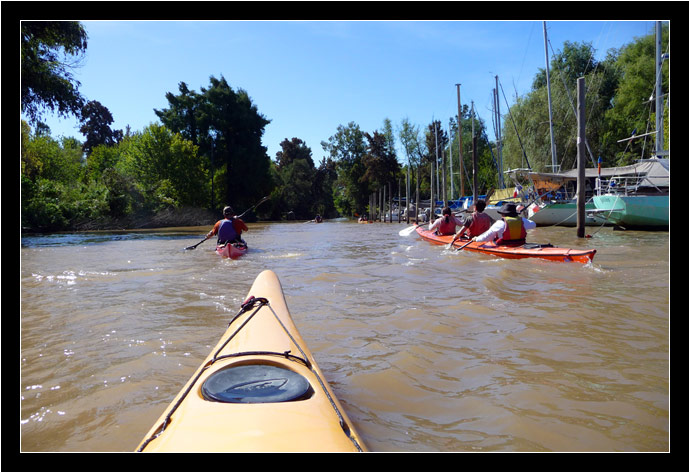
If you, like us, find yourself in the middle of Buenos Aires and want to get away from the city for a little while, you could do worse that heading up to Tigre and renting a Kayak. Delta en Kayak has a whole list of excursions, the most popular of which is probably paddling and camping during a full moon.
The lunar calendar didn’t cooperate for our stay, so we simply went for a 4-hour-or-so paddle along the rivers and canals around Tigre.
There’s no experience necessary as a guide accompanies your group and leads you along the waterways. They have 1-, 2-, and 3-person kayaks and all the equipment seemed in good repair (if not exactly new.) We paddled for about 3 hours total and the only worry was the wakes from passing boats. In the middle, we stopped for drinks and snacks at Delta en Kayak’s cabin, located on a serene shoreline set back from the louder boat traffic.
Where: Tigre, northern suburb of Buenos Aires, Argentina
Tour: Delta en Kayak
Cost: 65 pesos ($16.25 USD) — approximate cost; our friends wouldn’t let us pay!
Included: Spanish-speaking guide, kayaks and paddles, (communal) dry bag for valuables
Not included: Skirts for the kayaks – expect to get a little wet
0800-Vino Wine Tasting | April 2011
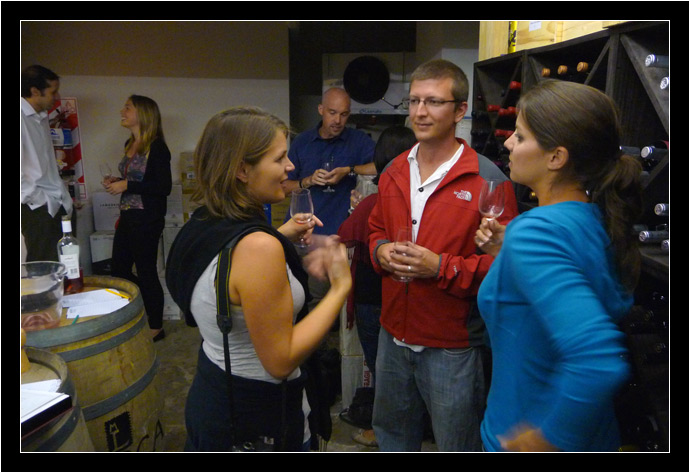
In the heart of Abasto, in Buenos Aires, there’s a nondescript door front. Inside that door is a nondescript office space. But below them both is a well-stocked wine cellar…
Nigel Tollerman, the British ex-pat owner of 0800-Vino, offers a variety of personalized wine and sommelier services. One of which is frequent hosted tastings. We got word that an Argentinean rosé tasting was being offered during our stay and decided to give it a go, not really knowing what to expect.
Once in the cellar, about 20 tourists idly stood around, waiting for the Nigel to lead. Once he began, every 15 minutes or so, he would open a different brand of wine, explain where and how it was made, then guide us in discovering it’s hidden textures, smells, and tastes, before invariably moving on to the next. It was an educational and intoxicating (literally) experience! Half way through, once the alcohol had loosened everyone up, we mingled freely with our fellow travelers and the cellar transformed itself from dignified and quiet to boisterous and entertaining!
Good for both newcomers to the wine industry who want to learn a little more about what they’re drinking as well as for experienced sommeliers who want to discover new, local wines, 0800-Vinos is simply a great experience.
Note: The best way to find out about upcoming tastings may be to join Nigel’s mailing list, follow @nigeltollerman on Twitter, or follow Cero Ochocientos Vino on Facebook.
Where: Abasto, Buenos Aires, Argentina
Tour: 0800-Vino
Cost: 50 pesos ($12.50 USD; an absolute steal!)
Included: 8 wine tastings, crackers, and as much information as you’d like to absorb
